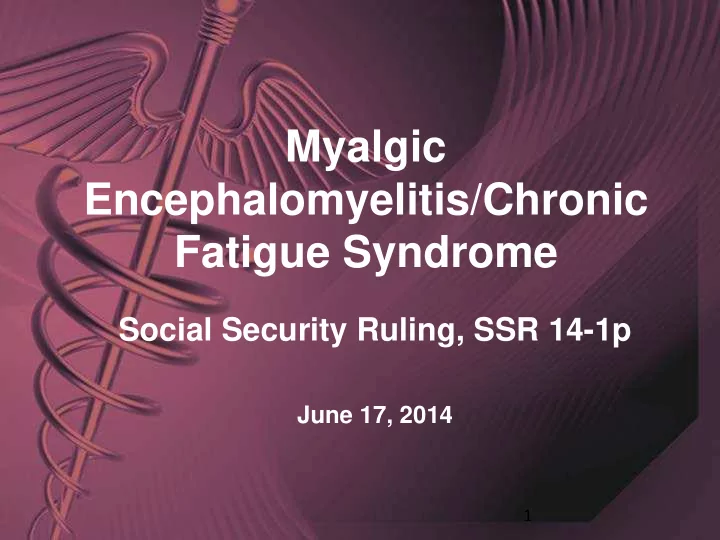

Myalgic Encephalomyelitis/Chronic Fatigue Syndrome Social Security Ruling, SSR 14-1p June 17, 2014 1
Social Security Ruling 14-1p Became Effective: April 3, 2014 Federal Register (79 FR 18750) Updates SSR 99-2p (1999)
SSA’s Definitive Policy • ME/CFS can constitute a medically determinable impairment (MDI), and • ME/CFS can be a severe MDI that is disabling under title II and title XVI of the Social Security Act (SSA’s disability programs)
What Does SSR 14-1p Do? Two Main Things: 1. Helps us establish that a person has an MDI of ME/CFS 2. Helps us determine that the person’s ME/CFS is disabling
How does SSR 14-1p Establish the MDI of ME/CFS? By Considering the Person’s: • Symptoms • Medical Signs • Laboratory Findings
What Information Sources Did We Use? Sources: • Centers for Disease Control & Prevention (CDC) • Canadian Consensus Criteria (CCC) • International Consensus Criteria (ICC) • SSA’s Adjudicative Experience
Hallmark Symptom Profound Fatigue • Persistent or relapsing • Lasting 6 months or more • Of new or definite onset • Cannot be explained by another physical or mental disorder • Is not the result of ongoing exertion • Is not substantially alleviated by rest • Results in substantial reduction in previous levels of occupational, educational, social, or personal activities
Other Symptoms We tell adjudicators to look for: • Multi-joint pain without • Self-reported short-term joint swelling or memory or redness concentration problems • Headaches of new • Sore throat type/pattern/severity • Tender cervical/axillary • Unrefreshing sleep lymph nodes • Postexertional malaise • Muscle pain
Other Symptoms (continued) Under SSR 14-1p, we tell adjudicators to also look for: • Muscle weakness • Disturbed sleep patterns (for example, insomnia, prolonged sleeping, frequent awakenings, or vivid dreams or nightmares • Visual difficulties (for example, trouble focusing, impaired depth perception, severe photosensitivity, or eye pain
Other Symptoms (continued) • Orthostatic intolerance (for example, lightheadedness, fainting, dizziness, increased fatigue with prolonged standing) • Respiratory difficulties (for example, labored breathing, sudden breathlessness) • Cardiovascular abnormalities (for example, palpitations with or without cardiac arrhythmias)
Other Symptoms (continued) • Gastrointestinal discomfort (for example, nausea, bloating, or abdominal pain) • Urinary or bladder problems (for example, urinary frequency, nocturia, dysuria, or pain in the bladder region)
Medical Signs We tell adjudicators to look for: • Palpably swollen or tender lymph nodes on physical examination • Nonexudative pharyngitis • Persistent, reproducible muscle tenderness on repeated examinations, including the presence of positive tender points • Any other medical signs that are consistent with medically acceptable clinical practice
Other Signs Under SSR 14-1p, we tell adjudicators to also look for: • Frequent viral infections with prolonged recovery • Sinusitis • Ataxia • Extreme pallor • Pronounced weight change
Laboratory Findings We tell adjudicators to look for: • An elevated antibody titer of Epstein-Barr virus (EBV) capsid antigen equal to or greater than 1:5120, or early antigen equal to or greater than 1:640 • An abnormal MRI brain scan • Neurally mediated hypotension as shown by tilt-table testing or another clinically accepted form of testing
Lab Findings (contnued) Any other laboratory findings that are consistent with medically accepted clinical practice and are consistent with the other evidence in the case record. For example, an abnormal exercise stress test or abnormal sleep studies.
Lab Findings (continued) We also tell adjudicators: As medical research advances regarding CFS, we may discover additional laboratory findings (and medical signs). For example, scientific studies suggest that a finding of Human Herpes Virus 6 may support the diagnosis of ME/CFS.
Co-Occurring Conditions We tell adjudicators to also look for: • Fibromyalgia; • Raynaud’s phenomenon; • Myofascial pain syndrome; • Migraines; • Temporomandibular • Chronic lymphocytic joint syndrome; thyroiditis; • Irritable bowel • Sjogren’s syndrome syndrome; • Interstitial cystitis;
Co-Occurring Conditions (continued) • New allergies or sensitivities to foods, odors, chemicals, medications, noise, vibrations or touch • Loss of thermostatic stability – Chills – Night sweats – Intolerance of extreme temperatures
After Establishing the MDI Determine Disability: 5-Step Sequential Evaluation 1. Is the person currently working? 2. Does the person have a severe impairment? 3. Does the impairment meet a listing? 4. Can the person do past work? 5. Can the person do any work?
Meet a Listing? Step Three: • ME/CFS cannot meet a listing because we do not have a listing for this disease • ME/CFS may medically equal a listing; for example, repeated manifestations of undifferentiated or mixed connective tissue disease, under the immune disorders body system
Listing 14.06B Undifferentiated or Mixed Connective Tissue Disease Repeated Manifestations: • Low-grade fevers • Fatigue • Swollen nodes • Raynaud’s-like symptoms • Shortness of breath • Muscle or joint pain • Photosensitivity or achiness • Dry mouth or eyes • Muscle weakness • Weight loss
Listing 14.06B Undifferentiated or Mixed Connective Tissue Disease Two or more constitutional signs: • Severe fatigue • Fever • Malaise • Involuntary weight loss
Listing 14.06B (continued) Undifferentiated or Mixed Connective Tissue Disease A marked limitation in one of three general areas of functioning: • Activities of daily living • Social functioning • Completing tasks in a timely manner due to deficiencies in concentration, persistence, or pace
Questions?
Recommend
More recommend